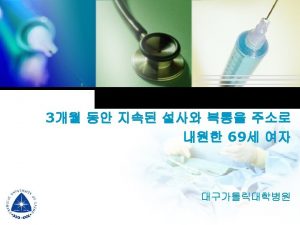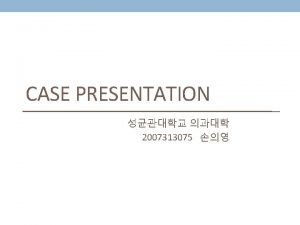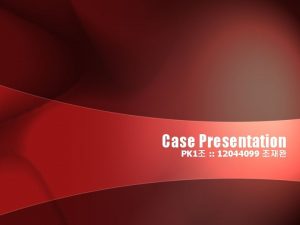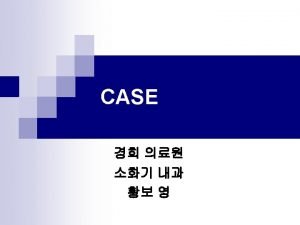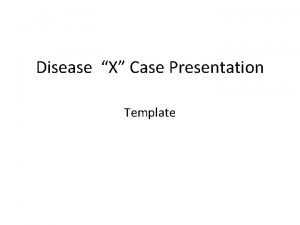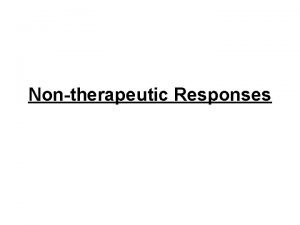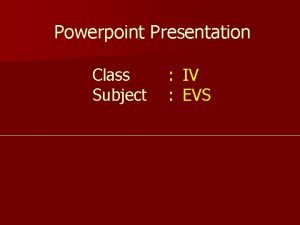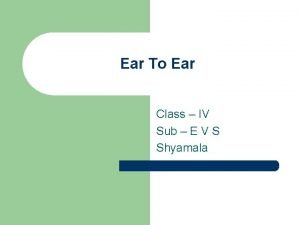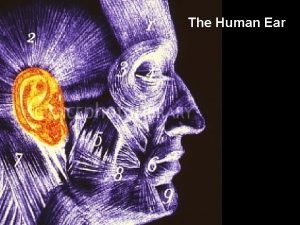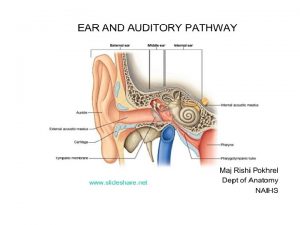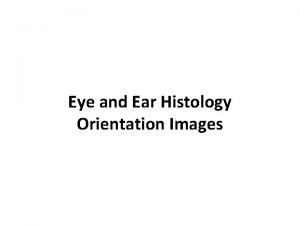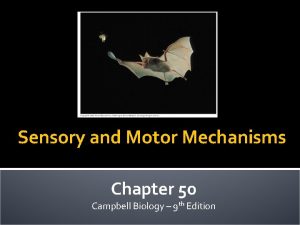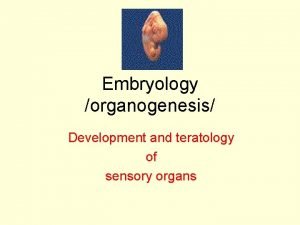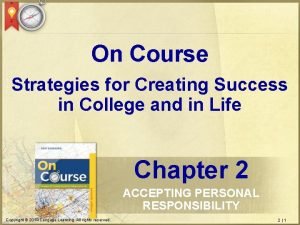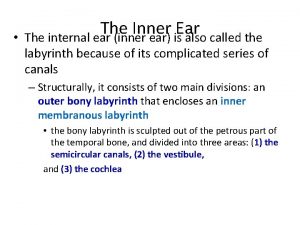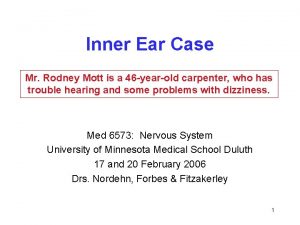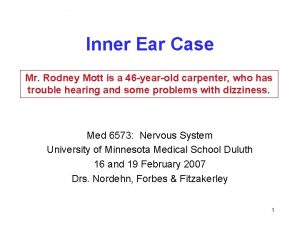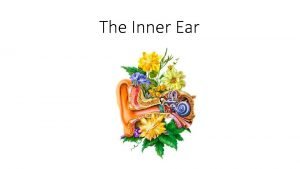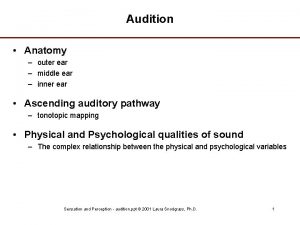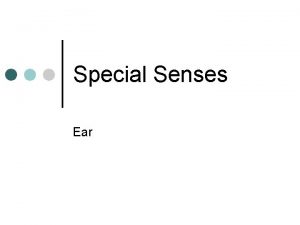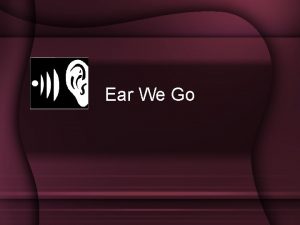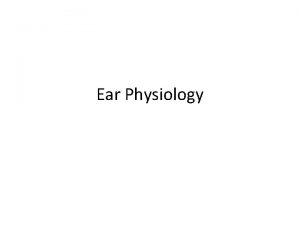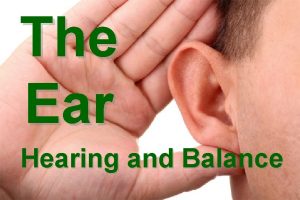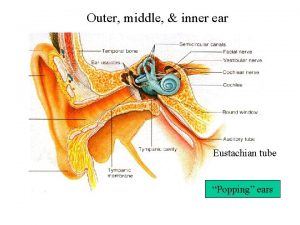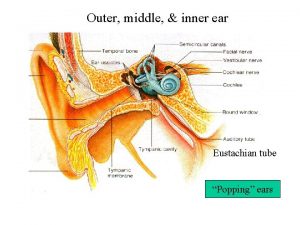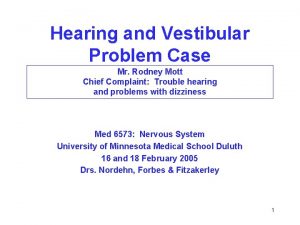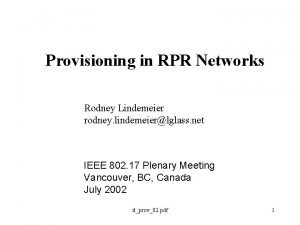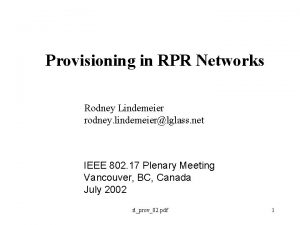Inner Ear Case Mr Rodney Mott Chief Complaint


















- Slides: 18

Inner Ear Case Mr. Rodney Mott Chief Complaint: Trouble hearing and problems with dizziness Med 6573: Nervous System University of Minnesota Medical School Duluth 17 and 20 February 2006 Drs. Nordehn, Forbes & Fitzakerley 1

YOU MUST PREPARE PRIOR TO THE SESSION ON FRIDAY, FEBRUARY 17 2005, 9: 00 A. M. Review the information provided in this handout relative to: Mr. Mott’s present and past history, meds, allergies and habits. • Note significant data. • Try to answer the questions that are posed on slide 5. • Be prepared to discuss the case. 2

Mr. Rodney Mott is a 46 -year-old carpenter, who has trouble hearing and some problems with dizziness. History of the Present Illness: Mr. Mott noted he was having trouble hearing his teakettle. At times he heard whistling in his ears that was not the teakettle and at other times he could not hear the kettle when it did whistle. This has been going on for several months, getting gradually worse in both ears. One morning, about three months ago, while getting out of bed, he began to hear whistling in his ears that became progressively louder. At the point where it was becoming annoying, he suddenly felt the room begin to spin. He sat down, but this gave him no relief. He became nauseated and eventually vomited. Because the spinning persisted, he climbed back into bed and found himself to be more comfortable when he lay on his right side with his eyes open. Within one half hour the spinning had stopped and the whistling also diminished. Since then, he has had several similar episodes, each beginning with increasing whistling followed by the spinning sensation. Mild hearing problems and whistling in both ears persist but the sounds seem louder in his left ear. Between his attacks he feels quite well and has no difficulty with his strength and coordination. 3

Past Medical History: Usual childhood illnesses. No history of heart disease, diabetes, stroke, convulsions or hypertension. Approximately 5 years ago, he was hospitalized for severe burns on his hands and forearms. He remembers being told that the IV he was given contained antibiotics. He resents the fact that he is still paying for that hospitalization. Three years ago, he suffered a blow to the head while playing volleyball, lost consciousness for a few minutes but was not seen by a physician. He has a history of his hands and feet "feeling puffy", so he has been using his neighbor's furosemide for a couple of years to treat this himself. Habits: Smokes one half pack per day since the age of 20 and has not tried to quit. Drinks one to two beer at dinnertime three to four times per week, but does not drink hard liquor. Does not use street drugs. Social History: Divorced 12 years ago. Works as a carpenter (self-employed). He has one older brother who has had some hearing problems, but he has no details about his brother’s condition. His parents are both alive and have had no serious medical problems. He graduated from high school at age 18, and is happy in his work. 4

What are the important problems that Mr. Mott is having? Be specific. What are the potential causes of these problems? What aspects of history might have contributed to the problems that Mr. Mott is having? What part(s) of the nervous system is(are) involved and why? What physical exam procedures are you going to perform to test your hypotheses? 5

What are the important problems that Mr. Mott is having? Be specific. timing • vertigo • whistling • episodic • louder in left ear • nausea/vomiting • hearing loss – high frequency 6

What are the potential causes of these problems? 1. stereocilia damage – noise induced, aminoglycoside antibiotics 2. alcohol and tobacco 3. furosemide 4. toxins(? ) 5. genetics 6. trauma 7. otosclerosis 8. Meniere’s disease 9. “other” neurological problem – tumour etc. 10. internal carotid artery (atherosclerosis) 11. high blood pressure 7

What part(s) of the nervous system is(are) involved and why? • • • semicircular canals “auditory processing” center vestibular nuclei cochlea cerebellum middle ear in common? endolymphatic duct? 8

What physical exam procedures are you going to perform to test your hypotheses? • • • Rinne/Weber audiogram (whisper test, wristwatch) neurological exam otoscope blood pressure 9

Physical Examination Findings General Appearance • Mr. Mott is a 46 -year-old white male in no apparent distress. Vital Signs • Height = 198 cm; Weight = 89. 3 kg Temperature = 37. 0 °C (oral) • Heart rate = 70 beats/min • Blood pressure = 100/60 mm. Hg (Sitting) • Respiratory rate = 14 breaths/min Oxygen saturation = 97% 10

Physical Examination Findings (continued) HEENT: • Eyes: Pupils equal, round and reactive to light (PERRL), Extra ocular movements intact (EOMI), no nystagmus and optical disks sharp. • Neck: Trachea in midline. Thyroid normal size. No lymphadenopathy. • Mouth: Oral mucous membranes pink and normal hydration. • Ears: Tympanic membranes visualized and clear, pearly gray. Rinne testnormal (air >bone) bilateral. Weber abnormal (lateralizes to right). Hearing loss with marginal. Loss of speech discrimination. Unable to hear the tick of a watch in both ears. Lungs, cardiovascular, abdominal exam: Normal Neurological exam: Normal with the exception of VIII (see above) 11

Near the end of the physical examination, Mr. Mott noted that the whistling in his ears was increasing and he had a mild attack of spinning sensation. He felt nauseated but did not vomit. During the attack, he developed a rightward nystagmus. The spinning, whistling and nystagmus lasted about 10 minutes. 12

Identify the abnormal and pertinent normal findings on the physical examination. Abnormal: no nystagmus rightward nystagmus Weber test right tinnitus Normal: BP TM Rinne 13

What are the potential causes of these problems? 1. stereocilia damage – noise induced, aminoglycoside antibiotics 2. alcohol and tobacco 3. furosemide 4. toxins(? ) 5. genetics 6. trauma 7. otosclerosis 8. Meniere’s disease 9. “other” neurological problem – tumour etc. 10. internal carotid artery (atherosclerosis) 11. high blood pressure 14

Laboratory Results Test Results Normal WBC Count Normal Lyme disease antibody titer Negative FTA-ABS (serum) Nonreactive Na+ 140 me. Q/L 136 -145 me. Q/L Cl- 100 me. Q/L 95 -105 me. Q/L K+ 3 me. Q/L 3. 5 -5 me. Q/L HCO 3 - 25 me. Q/L 22 -28 me. Q/L BUN 14 mg/d. L 13 -17 mg/d. L Creatinine 0. 85 mg/d. L 0. 6 -1. 3 mg/d. L (men) Glucose (postprandial) 114 <140 mg/d. L Vitamin B 12 720 ng/m. L 190 -900 ng/m. L Folate 8 ng/m. L 2 -10 ng/m. L Cholesterol (total) 188 mg/d. L <200 mg/d. L 15

Audiometry 16

17

C A D B 18
 By listening to my inner defender voice i can be sure that
By listening to my inner defender voice i can be sure that Diarrhea chief complaint
Diarrhea chief complaint Chief complaint present illness
Chief complaint present illness Cc hpi pmh
Cc hpi pmh Chief complaint of colostomy
Chief complaint of colostomy History of present illness example
History of present illness example Chief
Chief Chief complaint of hemorrhoids
Chief complaint of hemorrhoids Chief complaint template
Chief complaint template Pqrstu mnemonic
Pqrstu mnemonic Slidetodoc
Slidetodoc An animal ears like leaves
An animal ears like leaves Chapter 9 lesson 3 commander in chief and chief diplomat
Chapter 9 lesson 3 commander in chief and chief diplomat U
U Antihelical crus
Antihelical crus Fovea centralis histology
Fovea centralis histology Ear inner structure
Ear inner structure Ear development
Ear development Inner critic and inner defender
Inner critic and inner defender

